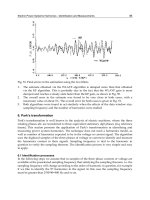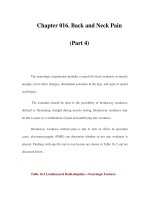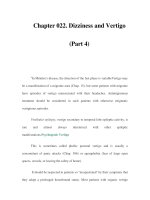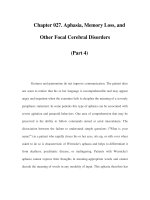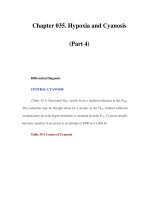Chapter 122. Acute Infectious Diarrheal Diseases and Bacterial Food Poisoning (Part 4) doc
Bạn đang xem bản rút gọn của tài liệu. Xem và tải ngay bản đầy đủ của tài liệu tại đây (58.63 KB, 7 trang )
Chapter 122. Acute Infectious Diarrheal Diseases
and Bacterial Food Poisoning
(Part 4)
Host Defenses
Given the enormous number of microorganisms ingested with every meal,
the normal host must combat a constant influx of potential enteric pathogens.
Studies of infections in patients with alterations in defense mechanisms have led to
a greater understanding of the variety of ways in which the normal host can protect
itself against disease.
Normal Flora
The large numbers of bacteria that normally inhabit the intestine act as an
important host defense by preventing colonization by potential enteric pathogens.
Persons with fewer intestinal bacteria, such as infants who have not yet developed
normal enteric colonization or patients receiving antibiotics, are at significantly
greater risk of developing infections with enteric pathogens. The composition of
the intestinal flora is as important as the number of organisms present. More than
99% of the normal colonic flora is made up of anaerobic bacteria, and the acidic
pH and volatile fatty acids produced by these organisms appear to be critical
elements in resistance to colonization.
Gastric Acid
The acidic pH of the stomach is an important barrier to enteric pathogens,
and an increased frequency of infections due to Salmonella, G. lamblia, and a
variety of helminths has been reported among patients who have undergone gastric
surgery or are achlorhydric for some other reason. Neutralization of gastric acid
with antacids or H
2
blockers—a common practice in the management of
hospitalized patients—similarly increases the risk of enteric colonization. In
addition, some microorganisms can survive the extreme acidity of the gastric
environment; rotavirus, for example, is highly stable to acidity.
Intestinal Motility
Normal peristalsis is the major mechanism for clearance of bacteria from
the proximal small intestine. When intestinal motility is impaired (e.g., by
treatment with opiates or other antimotility drugs, anatomic abnormalities, or
hypomotility states), the frequency of bacterial overgrowth and infection of the
small bowel with enteric pathogens is increased. Some patients whose treatment
for Shigella infection consists of diphenoxylate hydrochloride with atropine
(Lomotil) experience prolonged fever and shedding of organisms, while patients
treated with opiates for mild Salmonella gastroenteritis have a higher frequency of
bacteremia than those not treated with opiates.
Immunity
Both cellular immune responses and antibody production play important
roles in protection from enteric infections. The wide spectrum of viral, bacterial,
parasitic, and fungal gastrointestinal infections in patients with AIDS highlights
the significance of cell-mediated immunity in protection from these pathogens.
Humoral immunity is also important and consists of systemic IgG and IgM as well
as secretory IgA. The mucosal immune system may be the first line of defense
against many gastrointestinal pathogens. The binding of bacterial antigens to the
luminal surface of M cells in the distal small bowel and the subsequent
presentation of antigens to subepithelial lymphoid tissue lead to the proliferation
of sensitized lymphocytes. These lymphocytes circulate and populate all of the
mucosal tissues of the body as IgA-secreting plasma cells.
Genetic Determinants
The mechanisms underlying genetic variation in host susceptibility remain
poorly understood. People with blood group O show increased susceptibility to
cholera, shigellosis, and norovirus infection. A polymorphism in the interleukin 8
gene is associated with increased risk of diarrhea from enteroaggregative E. coli.
Approach to the Patient: Infectious Diarrhea or Bacterial Food
Poisoning
The approach to the patient with possible infectious diarrhea or bacterial
food poisoning is shown in Fig. 122-1.
Figure 122-1
Clinical algorithm for the approach to patients with community-
acquired infectious diarrhea or bacterial food poisoning.
Key to superscripts:
1.
Diarrhea lasting >2 weeks is generally defined as chronic; in such cases, many
of the causes of acute diarrhea are much less likely, and a new spectrum of causes
needs to be considered. 2.
Fever often implies invasive disease, although fever and
diarrhe
a may also result from infection outside the gastrointestinal tract, as in
malaria. 3.
Stools that contain blood or mucus indicate ulceration of the large
bowel. Bloody stools without fecal leukocytes should alert the laboratory to the
possibility of infection with Shiga toxin–
producing enterohemorrhagic
Escherichia coli. Bulky white stools suggest a small-
intestinal process that is
causing malabsorption. Profuse "rice-
water" stools suggest cholera or a similar
toxigenic process. 4. Frequent stools over a g
iven period can provide the first
warning of impending dehydration. 5.
Abdominal pain may be most severe in
inflammatory processes like those due to Shigella, Campylobacter
, and
necrotizing toxins. Painful abdominal muscle cramps, caused by electrolyte los
s,
can develop in severe cases of cholera. Bloating is common in giardiasis. An
appendicitis-like syndrome should prompt a culture for Yersinia enterocolitica
with cold enrichment. 6.
Tenesmus (painful rectal spasms with a strong urge to
defecate but littl
e passage of stool) may be a feature of cases with proctitis, as in
shigellosis or amebiasis. 7. Vomiting implies an acute infection (e.g., a toxin-
mediated illness or food poisoning) but can also be prominent in a variety of
systemic illnesses (e.g., malaria) and in intestinal obstruction. 8.
Asking patients
whether anyone else they know is sick is a more efficient means of identifying a
common source than is constructing a list of recently eaten foods. If a common
source seems likely, specific foods can b
e investigated. See text for a discussion
of bacterial food poisoning. 9.
Current antibiotic therapy or a recent history of
treatment suggests Clostridium difficile
diarrhea (Chap. 123). Stop antibiotic
treatment if possible and consider tests for C. difficile
toxins. Antibiotic use may
increase the risk of other infections, such as salmonellosis. 10.
See text (and Chap.
117) for a discussion of traveler's diarrhea. (
After Guerrant and Steiner; RL
Guerrant, DA Bobak: N Engl J Med 325:327, 1991; with permission.)
